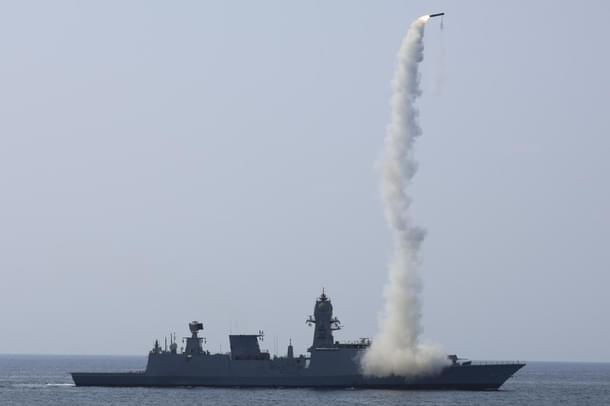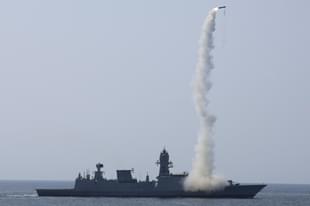News Brief
Readiness Against Pakistan: Navy Conducts Anti-Ship Firings, Army Retaliates To LoC Provocations, IAF Activates Western Front Bases
Nishtha Anushree
Apr 28, 2025, 01:10 PM | Updated 01:10 PM IST
Save & read from anywhere!
Bookmark stories for easy access on any device or the Swarajya app.


India is maintaining pressure on Pakistan by demonstrating significant military strength along both land and maritime borders. This includes the Army's robust response to ceasefire violations along the Line of Control, the Navy's execution of multiple missile launches from warships in the Arabian Sea, and the Indian Air Force's (IAF) operation of extended-range day and night fighter missions.
The Indian Navy announced on Sunday (27 April) that its "ships undertook successful multiple anti-ship firings to revalidate and demonstrate the readiness of platforms, systems and crew for a long-range precision offensive strike."
The intensification of pressure appears to be a tactic aimed at keeping Pakistan in a state of unease until decisive actions can be executed in a cool, deliberate way, should the government choose to do so. This would be after considering the necessary escalation framework and ensuring that nuclear boundaries are not breached.
Over the recent days, at least four leading destroyers and frigates in the Arabian Sea have conducted test-firing of BrahMos supersonic cruise missiles and other weapons. The strike range of these missiles has been increased from the initial 290 km to 450 km, Times of India reported.
The BrahMos, an air-breathing missile that travels nearly triple the speed of sound at Mach 2.8, serves as the main conventional (non-nuclear) precision-strike weaponry for the military forces.
The Army boasts a minimum of four BrahMos regiments, and the IAF is equipped with both land-based batteries and 40 Sukhoi-30MKI fighter jets fitted with the more streamlined air-to-ground missile versions. These assets, together with other stand-off weapons, are likely to be deployed if the Indian government chooses to implement the military strategy of limited punitive strikes against Pakistan.
"Both Prime Minister Narendra Modi and Defence Minister Rajnath Singh have made it quite clear that there will deadly retribution for not only the perpetrators of the Pahalgam massacre but also their masters pulling the strings from behind the scenes," a senior officer was quoted as saying by ToI.
The Army reported that numerous posts of the Pakistan Army had once more "started unprovoked firing" using small arms such as rifles and light machine guns targeting Indian positions in various regions. These regions included Tutmari Gali, Rampur, Uri, Gurez, and Sunderbani sectors, and the incidents occurred late on Saturday night.
"Our troops responded in double measure effectively with appropriate small arms fire. If Pakistan Army begins using higher-calibre weapons (artillery guns, anti-tank guided missiles and 120mm mortars), we will also open up with them," a senior officer was quoted as saying by ToI.
"Heavy costs can certainly be imposed on the Pakistan Army for fuelling cross-border terrorism. It was the norm before the fresh understanding between the Indian and Pakistan DGMOs in February 2021 to maintain peace. Our dynamic response strategy is fully in place," he added.
The IAF is also maintaining an elevated level of operational readiness. All air bases on the western front have been fully activated, with fighter jets performing regular Combat Air Patrols (CAPs). Additionally, air defence missile systems are prepared to intercept any aerial threats.
Nishtha Anushree is Senior Sub-editor at Swarajya. She tweets at @nishthaanushree.





